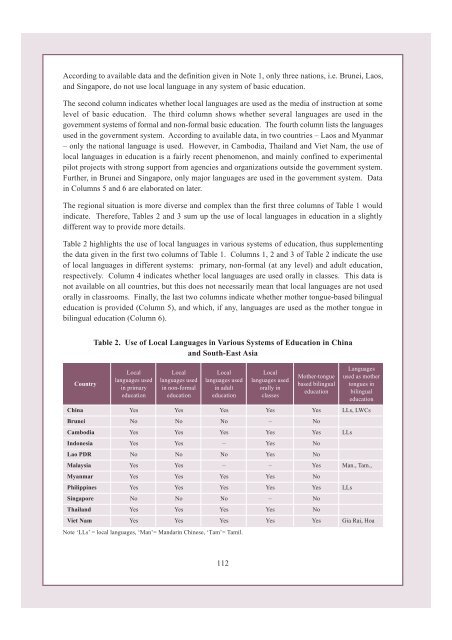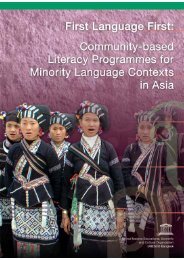Part II.pdf - MTB-MLE Network
Part II.pdf - MTB-MLE Network
Part II.pdf - MTB-MLE Network
Create successful ePaper yourself
Turn your PDF publications into a flip-book with our unique Google optimized e-Paper software.
According to available data and the definition given in Note 1, only three nations, i.e. Brunei, Laos,<br />
and Singapore, do not use local language in any system of basic education.<br />
The second column indicates whether local languages are used as the media of instruction at some<br />
level of basic education. The third column shows whether several languages are used in the<br />
government systems of formal and non-formal basic education. The fourth column lists the languages<br />
used in the government system. According to available data, in two countries – Laos and Myanmar<br />
– only the national language is used. However, in Cambodia, Thailand and Viet Nam, the use of<br />
local languages in education is a fairly recent phenomenon, and mainly confined to experimental<br />
pilot projects with strong support from agencies and organizations outside the government system.<br />
Further, in Brunei and Singapore, only major languages are used in the government system. Data<br />
in Columns 5 and 6 are elaborated on later.<br />
The regional situation is more diverse and complex than the first three columns of Table 1 would<br />
indicate. Therefore, Tables 2 and 3 sum up the use of local languages in education in a slightly<br />
different way to provide more details.<br />
Table 2 highlights the use of local languages in various systems of education, thus supplementing<br />
the data given in the first two columns of Table 1. Columns 1, 2 and 3 of Table 2 indicate the use<br />
of local languages in different systems: primary, non-formal (at any level) and adult education,<br />
respectively. Column 4 indicates whether local languages are used orally in classes. This data is<br />
not available on all countries, but this does not necessarily mean that local languages are not used<br />
orally in classrooms. Finally, the last two columns indicate whether mother tongue-based bilingual<br />
education is provided (Column 5), and which, if any, languages are used as the mother tongue in<br />
bilingual education (Column 6).<br />
Country<br />
Table 2. Use of Local Languages in Various Systems of Education in China<br />
and South-East Asia<br />
Local Local Local Local<br />
languages used languages used languages used languages used<br />
in primary in non-formal in adult orally in<br />
education education education classes<br />
Mother-tongue<br />
based bilingual<br />
education<br />
Languages<br />
used as mother<br />
tongues in<br />
bilingual<br />
education<br />
China Yes Yes Yes Yes Yes LLs, LWCs<br />
Brunei No No No – No<br />
Cambodia Yes Yes Yes Yes Yes LLs<br />
Indonesia Yes Yes – Yes No<br />
Lao PDR No No No Yes No<br />
Malaysia Yes Yes – – Yes Man., Tam.,<br />
Myanmar Yes Yes Yes Yes No<br />
Philippines Yes Yes Yes Yes Yes LLs<br />
Singapore No No No – No<br />
Thailand Yes Yes Yes Yes No<br />
Viet Nam Yes Yes Yes Yes Yes Gia Rai, Hoa<br />
Note ‘LLs’ = local languages, ‘Man’= Mandarin Chinese, ‘Tam’= Tamil.<br />
112
















